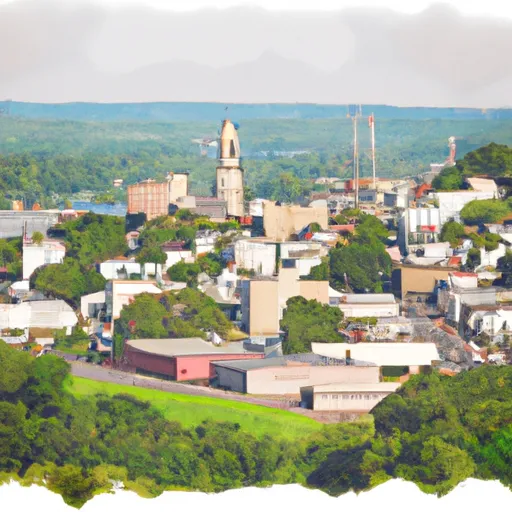-
 Snoflo Premium
Snoflo Premium
Get unlimited access to all our content
With no Ad interruptions! - Start Your Free Trial Login with existing account
Sciota
Eden Index
Climate
9.0
•
Recreation
5.0
•
Community
1.0
•
Safeguard
5.6/10

Sciota, Pennsylvania is a small community located in Monroe County, nestled in the picturesque Pocono Mountains region. The area experiences a humid continental climate, characterized by warm summers and cold winters. Summers are generally mild, with average temperatures ranging from the mid-70s to low 80s Fahrenheit, while winters can be quite cold, with temperatures dropping below freezing and occasional snowfall.
Sciota benefits from its proximity to various water bodies, including the Brodhead Creek, which flows through the area. The hydrology constituents of Sciota consist of streams, wetlands, and small ponds, providing opportunities for fishing, kayaking, and leisurely walks along the water's edge. The Brodhead Creek is particularly popular among anglers, offering ample opportunities to catch trout and other freshwater fish species.
Outdoor enthusiasts will find plenty of recreation opportunities in Sciota and its surrounding areas. The region is dotted with nature trails and hiking paths, offering breathtaking views of the mountains, forests, and waterways. Nearby state parks, such as Big Pocono State Park and Delaware Water Gap National Recreation Area, provide additional opportunities for camping, picnicking, bird-watching, and wildlife spotting.
Overall, Sciota, Pennsylvania presents a charming destination for those seeking outdoor adventures, scenic beauty, and a chance to immerse themselves in nature's wonders.
What is the Eden Index?
The Snoflo Eden Index serves as a comprehensive rating system for regions, evaluating their desirability through a holistic assessment of climate health, outdoor recreation opportunities, and natural disaster risk, acknowledging the profound impact of these factors on livability and well-being.
Climate Health Indicator (CHI): 9.0
Sciota receives approximately
1291mm of rain per year,
with humidity levels near 79%
and air temperatures averaging around
10°C.
Sciota has a plant hardyness factor of
6, meaning
plants and agriculture in this region thrive during a short period during spring and early summer. Most
plants will die off during the colder winter months.
By considering the ideal temperature range, reliable water supplies, clean air, and stable seasonal rain or snowpacks, the Climate Health Indicator (CHI) underscores the significance of a healthy climate as the foundation for quality living.
A healthy climate is paramount for ensuring a high quality of life and livability in a region, fostering both physical well-being and environmental harmony. This can be characterized by ideal temperatures, reliable access to water supplies, clean air, and consistent seasonal rain or snowpacks.
Weather Forecast
Streamflow Conditions
Upper Delaware
Area Rivers
Upper Delaware
Snowpack Depths
Upper Delaware
Reservoir Storage Capacity
Upper Delaware
Groundwater Levels
Recreational Opportunity Index (ROI): 5.0
The Recreational Opportunity Index (ROI) recognizes the value of outdoor recreational options, such as parks, hiking trails, camping sites, and fishing spots, while acknowledging that climate plays a pivotal role in ensuring the comfort and consistency of these experiences.
Access to outdoor recreational opportunities, encompassing activities such as parks, hiking, camping, and fishing, is crucial for overall well-being, and the climate plays a pivotal role in enabling and enhancing these experiences, ensuring that individuals can engage in nature-based activities comfortably and consistently.
Camping Areas
| Campground | Campsites | Reservations | Toilets | Showers | Elevation |
|---|---|---|---|---|---|
| Wilsonville Rec Area - PPL | None | 1,195 ft | |||
| Ironwood Point Rec Area - PPL | 49 | 1,296 ft | |||
| Tobyhanna State Park | None | 1,985 ft | |||
| Promised Land State Park | None | 1,746 ft | |||
| Ledgedale Rec Area | None | 1,183 ft | |||
| Lake Towhee County Park | None | 509 ft | |||
| Caffrey Rec Area - PPL | 29 | 1,218 ft |
Nearby Fishing
Nearby Ski Areas
Catastrophe Safeguard Index (CSI):
The Catastrophe Safeguard Index (CSI) recognizes that natural disaster risk, encompassing floods, fires, hurricanes, and tornadoes, can drastically affect safety and the overall appeal of an area.
The level of natural disaster risk in a region significantly affects safety and the overall livability, with climate change amplifying these risks by potentially increasing the frequency and intensity of events like floods, fires, hurricanes, and tornadoes, thereby posing substantial challenges to community resilience and well-being.
Community Resilience Indicator (CRI): 1.0
The Community Resilience Indicator (CRI) recognizes that education, healthcare, and socioeconomics are crucial to the well-being of a region. The CRI acknowledges the profound impact of these elements on residents' overall quality of life. By evaluating educational resources, healthcare accessibility, and economic inclusivity, the index captures the essential aspects that contribute to a thriving community, fostering resident satisfaction, equity, and social cohesion.

